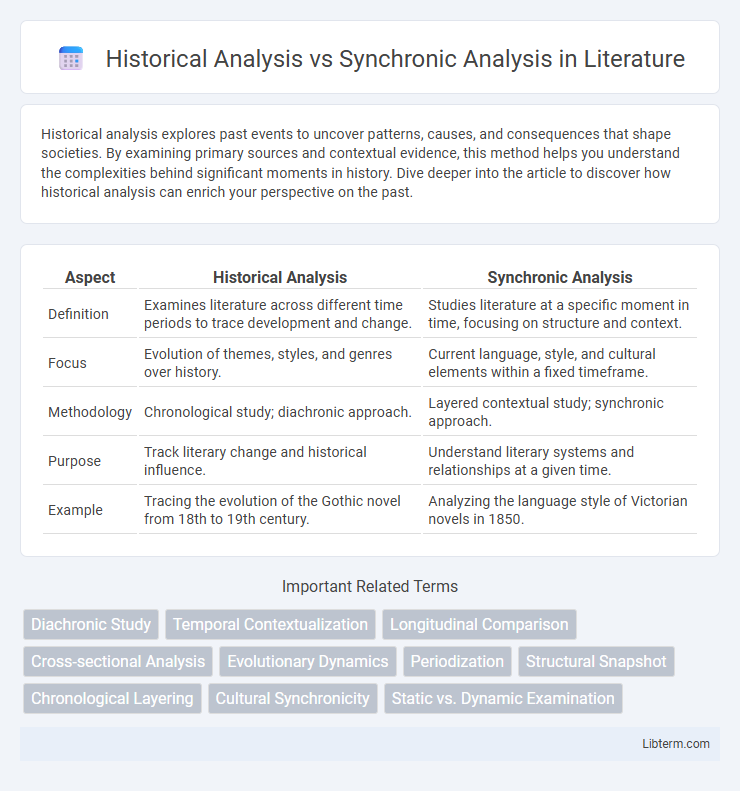Historical analysis explores past events to uncover patterns, causes, and consequences that shape societies. By examining primary sources and contextual evidence, this method helps you understand the complexities behind significant moments in history. Dive deeper into the article to discover how historical analysis can enrich your perspective on the past.
Table of Comparison
| Aspect | Historical Analysis | Synchronic Analysis |
|---|---|---|
| Definition | Examines literature across different time periods to trace development and change. | Studies literature at a specific moment in time, focusing on structure and context. |
| Focus | Evolution of themes, styles, and genres over history. | Current language, style, and cultural elements within a fixed timeframe. |
| Methodology | Chronological study; diachronic approach. | Layered contextual study; synchronic approach. |
| Purpose | Track literary change and historical influence. | Understand literary systems and relationships at a given time. |
| Example | Tracing the evolution of the Gothic novel from 18th to 19th century. | Analyzing the language style of Victorian novels in 1850. |
Introduction to Historical and Synchronic Analysis
Historical analysis examines changes in phenomena over time by tracing development, causes, and effects within chronological sequences. Synchronic analysis studies a specific point or period, focusing on structures, relationships, and functions without considering temporal progression. Both methods are fundamental in disciplines like linguistics, anthropology, and sociology for understanding dynamic versus static aspects of cultural and social systems.
Defining Historical Analysis
Historical analysis involves examining events, developments, and contexts over a period to understand causes, effects, and patterns within a temporal framework. It emphasizes the chronological sequence and transformation of social, political, or cultural phenomena, providing insights into how past conditions influence present realities. Contrastingly, synchronic analysis studies phenomena at a specific point in time without considering historical progression.
Defining Synchronic Analysis
Synchronic analysis examines linguistic, cultural, or social phenomena at a specific point in time, without considering historical development or evolution. This method highlights structure, function, and relationships within a system as they coexist, enabling a clear snapshot of conditions during that period. It contrasts with historical analysis, which traces changes and progression over time.
Key Differences Between Historical and Synchronic Approaches
Historical analysis examines linguistic or cultural changes across time, emphasizing diachronic developments and evolution of meanings or structures. Synchronic analysis focuses on a specific moment, studying the system or context as it exists without regard to its historical development. Key differences include the temporal scope, with historical analysis prioritizing change over periods, while synchronic analysis prioritizes structure and function at a particular point in time.
Methodologies in Historical Analysis
Historical analysis employs longitudinal methodologies that examine changes and developments over extended periods by analyzing primary sources, archival data, and chronological events to uncover causal relationships and contextual influences. It uses comparative techniques to track transformations across different eras and geographical locations, enabling a comprehensive understanding of temporal dynamics. This approach contrasts with synchronic analysis, which studies phenomena at a single point in time without focusing on historical progression or evolution.
Methodologies in Synchronic Analysis
Synchronic analysis emphasizes examining linguistic structures or social phenomena at a specific point in time, utilizing static data sets such as contemporary corpora, surveys, and observational studies to capture current patterns and relationships. Methodologies in synchronic analysis include structural analysis, where elements are mapped and categorized to identify systemic functions, and descriptive statistics to quantify features within a snapshot context. This approach contrasts with diachronic methods by prioritizing synchronic descriptions over evolutionary sequences, allowing researchers to understand stability and variation within a controlled temporal framework.
Advantages of Historical Analysis
Historical analysis provides a comprehensive understanding of changes and developments over time, revealing patterns, trends, and causal relationships that shape current phenomena. It enables researchers to contextualize events within their specific temporal frameworks, enhancing the accuracy of interpretations and predictions. This depth of insight is invaluable for disciplines like sociology, anthropology, and history, where the evolution of social structures and cultural norms is critical for analysis.
Advantages of Synchronic Analysis
Synchronic analysis offers a clear advantage by examining phenomena at a specific point in time, allowing researchers to isolate variables and understand contemporary relationships without the confounding influence of historical change. This approach facilitates the identification of patterns, structures, and systems within a defined temporal context, providing actionable insights for current issues. In contrast to historical analysis, synchronic analysis enables more precise comparisons across similar entities or cases by controlling for temporal variation.
Applications and Case Studies
Historical analysis investigates changes and developments over time, making it essential for studying social movements, economic cycles, and linguistic evolution through longitudinal case studies. Synchronic analysis examines systems or phenomena at a specific point in time, commonly applied in sociolinguistics, market research, and cultural studies to identify patterns and structures without temporal context. Case studies utilizing historical analysis reveal causality and trends, while synchronic analysis emphasizes system states and relationships, providing complementary insights across disciplines.
Choosing the Right Approach for Your Research
Historical analysis examines phenomena by exploring changes over time through chronological data and context, making it ideal for research on development, trends, or evolution. Synchronic analysis focuses on a specific point in time to understand structures, relationships, or functions within a system, best suited for studies needing a snapshot perspective. Selecting the right approach depends on whether the research aims to capture dynamic progress or static conditions for accurate and relevant insights.
Historical Analysis Infographic

 libterm.com
libterm.com